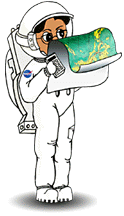![]()
 |
Guess what?The name comet comes from the Latin word cometa which means "long-haired". The earliest known record of a comet sighting was made by an astrologer of the Chinese court in 1059 B.C. |
| Scientists believe that comets are the debris left from the solar nebula which condensed to form the Sun and planets in our solar system. Most comets are thought to originate in a huge cloud called the Oort Cloud. The Oort Cloud is believed to surround our solar system and reach over halfway to the nearest star, Alpha Centauri, which is 150,000 astronomical units away. Scientists think that about 100 million comets orbit the Sun. A comet has a distinct center called a nucleus. Most astronomers think the nucleus is made of frozen water and gases mixed with dust and rocky material. Comet nuclei are described as dirty snowballs. A hazy cloud called a coma surrounds the nucleus. The coma and the nucleus together form the comet's head. |
|
|
Comets follow a regular orbit around the Sun. If the comet nucleus is pulled into an orbit which carries it close to the Sun, the solar heat will cause the outer layers of the icy nucleus to evaporate. During this process, dust and gases which form the coma around the nucleus are released. As the comet gets closer to the Sun, the coma grows. The solar winds push the dust and gas away from the coma causing them to stream off into space to form the comet's tail. The solar winds cause the comet's tail to point away from the Sun. The tails of comets can reach 150 million kilometers in length! Each time the comet passes close to the Sun, it loses some of its material. Over time, it will break up and disappear completely. |
A comet has no light of its own. We are able to see a comet because of the reflection of the Sun's light off of the comet and because of the gas molecules in the coma releasing energy absorbed from the Sun's rays.
| Show me a movie about cometsThis movie is large, but worth the wait! |
A QuestionAs a comet approaches the Sun, does its head or tail lead the way? As it moves around from the Sun, which parts leads? |
|
| Did you know? |
The Answer |
![]()
| Show me the Level 1 version of this page. |
The StarChild site is a service of the High Energy Astrophysics Science Archive Research Center (HEASARC), within the Astrophysics Science Division (ASD) at NASA/ GSFC.
StarChild Authors: The StarChild Team
StarChild Graphics & Music: Acknowledgments
StarChild Project Leader: Dr. Laura A.
Whitlock
Curator:
Responsible NASA Official: